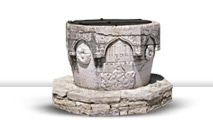
- Sečovlje Salt Pans - Dragonja River Valley
- Sv. Peter - Nova vas - Padna
- Pomjan - Nature Park: Karst Edge - Socerb
- Črni Kal - Osp - Kubed
- Momjan - Grožnjan - Pietrapelosa - Mirna
- Baštija - Kostanjica - Parenzana
- Oprtalj - Završje - Livade - Zrenj
- Istarske toplice - Motovun Forest - Višnjan
- Cave Mramornica - Feštini Kingdom - Cave Baredine
- Lim Bay - Kloštar - Kontija - Dvigrad
- Kanfanar - Bale - Palud - Vodnjan -Islands Brijuni - Fažana
- Svetvinčenat - Tinjan - Pićan - Gračišće
- Belaj - Šumber - Kožljak - Paz
- Čepićko Field - Kršan - Boljun Castle - Lupoglav
- Plomin - Kvarner Gulf - Brseč
- Nature park Učka - Mošćenice
Kanfanar - Bale - Palud - Vodnjan -Islands Brijuni - Fažana
Fažana
Its development was greatly determined by the Brijuni Islands as the nearest port. As early as the 1st c. the production of amphorae in this area was of great importance. The famous imperial Via Flavia that connected Trieste with Pula, passed by Fažana. In ancient documents Fažana is mentioned as a diocese which in the beginning of the 11th c., by the king's deed of gift became the possession of the bishops of Pula. It was then the property of different counts, Patriarchs of Aquileia and noble families from Pula. Centuries of Venetian rule had a great impact on the appearance of this coastal town. Here, battles between the Venetians and Genoese took place, and also ships set off for the Battle of Vis. During the Italian rule, until the war, Brijuni continued the tradition of an exclusive seaside resort, first through the family tradition of Kupelwieser's son and then as part of Italy. At this time various economic and trade activities developed in Fažana: the building of wooden boats, glass production, production of alcoholic and non-alcoholic beverages and fish-processing plant.
After World War I, Fažana, as well as entire Istria, comes under Italian rule, and after World War II it is a part of the Yugoslav republic of Croatia. The fact that Brijuni became Tito's residence defined the way of life of the surrounding area. Many different heads of state, political leaders from all continents, businessmen and artists visit Brijuni, but Fažana turns into a zone closed for foreigners, which defines its restricted area of prosperity. When the Republic of Croatia gains its independence, the production plants are moved, and parts are even closed down, the Brijuni Islands are open for visitors, and of course Fažana becomes attractive for tourists.
History is written in the Church of St. Eliseus erected on the ruins from the 6th c., Church of Our Lady of Mount Carmel with portico and bell gable from the 9th c. and frescoes from the 15th c. and the Parish Church of SS. Cosmas and Damian from the 15th c.

















